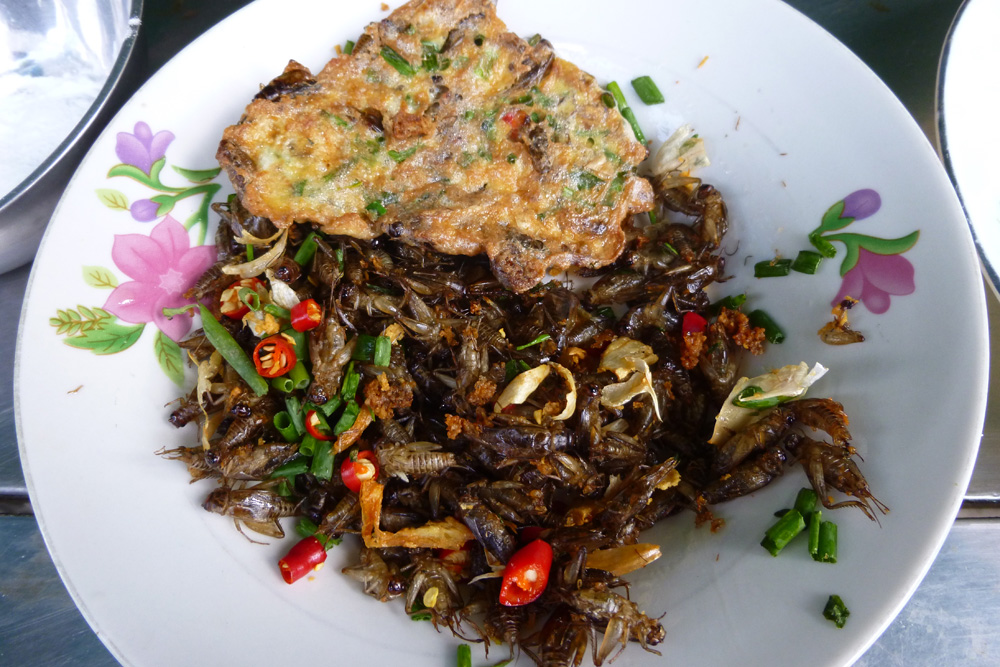If you meet one of those tourists who complains that there is nothing to do in Phnom Penh, one thing you can suggest is an insect cooking class.
The class, taught on the other side of the Monivong Bridge, gives visitors a chance to fry four types of crickets, silk worm larvae, and black water beetles. At the end of class, the cooks are encouraged to sample the dishes: that’s why the course is called “Fear Factor Challenge.”
“Some people just go there to take a look, but they say, ‘How can I eat that one?’ That’s why we came up with the name Fear Factor Challenge,” says Vann Kimlay, the Cambodia-based programme manager of Backstreet Academy, a Singaporean social enterprise that offers some unusual tourist activities in the city.
According to Kimlay, Backstreet Academy was launched here a year ago and also has classes on Khmer boxing, coconut carving, shadow puppets, and paper masks. Fruit carving classes are being planned.
It turns out that cooking bugs is easy because they don’t try to crawl or fly out of the frying pan. To start with, the crickets are already dead from being held in a bag of ice, while the larvae and black beetles are pre-boiled. The crickets are mixed with salt, sugar, MSG, and rice flour, deep fried in hot oil with garlic, and served with chili and green onion. The important thing is to keep stirring so that they don’t stick to the pan. The larvae are fried with chili and green onion, while the black beetles are deep fried.
Then comes the most challenging part: eating. On a Sunday afternoon, insect cooking student Cynthia Luna, 71, has to close her eyes as the translator drops a black beetle into her mouth.
“Oh God, I actually ate a roach!” she exclaims. “Don’t kill them – eat them!”
According to Luna, from Puerto Rica, the larvae taste like corn tortillas, the beetles are like Vietnamese salty crab, and the crickets remind her of garlic shrimp.
The crickets are the easiest ones to eat. Just scoop a handful into your hand and drop them into your mouth. Or you can tear the legs off first so they don’t get stuck in your mouth. Interestingly, female crickets taste differently from the male ones because they have eggs inside. To tell the difference, says course instructor Prech Vannet, look at their wings. Females have smooth wings, while the males’ wings are more wrinkly-looking.
“Normally, the female tastes better,” Vannet says, as he handpicks some female bugs for the foreigners.
Larvae are also soft inside, but it’s hard to escape the thought that they are worms in the making. Black beetles aren’t much better. After trying one, the foreigners don’t reach for seconds. According to Vannet, beetles are a popular snack with beer, so it’s best to keep some nearby to wash them down.
Vannet went into the insect trade after being a monk for 15 years. Nowadays, he claims he can make about $50 per day. The most popular snack is cricket, he says. They sell for $1 a cup.
“With this job, it’s easy to earn an income,” he says.
Vannet doesn’t catch the bugs himself, but buys them from middlemen. Each type of insect comes from a different province, he says.
According to Kimlay, most of the crickets are raised on farms, although some are collected by shining a bright light in the night. The crickets fly toward the light and die – although this method is dangerous because the light also attracts worms and poisonous snakes.
Although the practice of eating insects existed in Cambodia before the Civil War, it became more important during the Khmer Rouge period because there wasn’t enough food, Kimlay explains.
At the end of class, after cooking some bugs the Cambodian way, Luna buys an egg and makes a cricket omelette.
“I make omelettes with everything,” she says.
It was pretty good – if you didn’t look too closely.
The Backstreet Academy insect cooking class costs $18. Visit www.backstreetacademy.com for more information.
